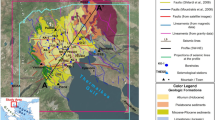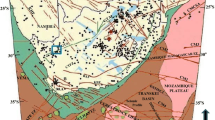Abstract
MOUNT Kenya is a large central volcano just south of the equator in central Kenya. It rises to a height of 5,199 m above sea level. The base of the volcano covers an area of approximately 7,000 sq km, and is roughly circular in plan with an average diameter of 105 km. A detailed geological study1 indicated that some 1,500 m of the upper part of the mountain has been removed by erosion since the volcano was formed in the Plio-Pleistocene.
Similar content being viewed by others
References
Baker, B. H., Rep. geol. Surv. Kenya, 79 (1967).
Emeleus, T. G., and Osborne, D. G., Annl Géophys., 24, 715–718 (1968).
Evernden, J. F., and Curtis, G. H., Curr. Anthropol., 6, 343–384 (1965).
Cox, A., Science, 163, 237–245 (1969).
Author information
Authors and Affiliations
Rights and permissions
About this article
Cite this article
SKINNER, N., BHATT, N. & HASTENRATH, S. Negative magnetic anomaly associated with Mount Kenya. Nature 250, 561–562 (1974). https://doi.org/10.1038/250561a0
Received:
Published:
Issue Date:
DOI: https://doi.org/10.1038/250561a0
- Springer Nature Limited





